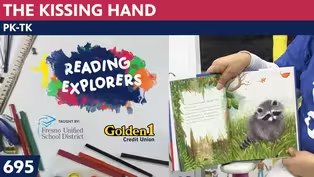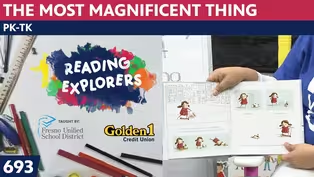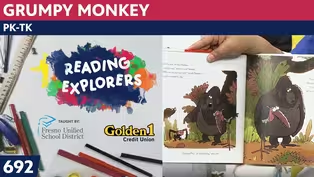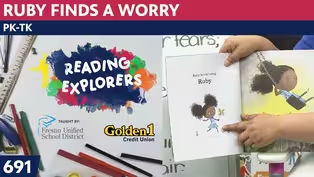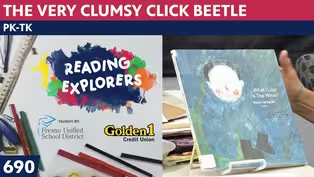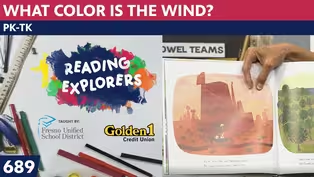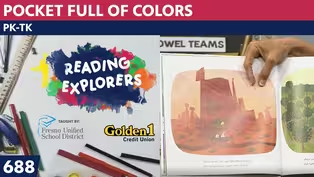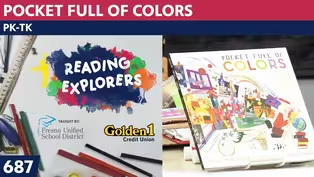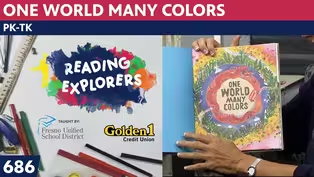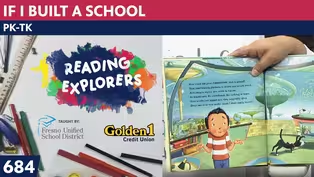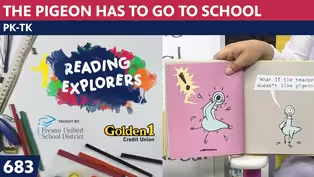
TK-383: Molly Hashimoto
Season 3 Episode 469 | 14m 4sVideo has Closed Captions
Join Mrs. Readwright at Camp Discovery!
Transitional Kindergarten teacher, Mrs. Readwright, welcomes students back to Camp Discovery, a fun learning space packed with reading adventures & fun games!
Problems playing video? | Closed Captioning Feedback
Problems playing video? | Closed Captioning Feedback
Reading Explorers is a local public television program presented by Valley PBS

TK-383: Molly Hashimoto
Season 3 Episode 469 | 14m 4sVideo has Closed Captions
Transitional Kindergarten teacher, Mrs. Readwright, welcomes students back to Camp Discovery, a fun learning space packed with reading adventures & fun games!
Problems playing video? | Closed Captioning Feedback
How to Watch Reading Explorers
Reading Explorers is available to stream on pbs.org and the free PBS App, available on iPhone, Apple TV, Android TV, Android smartphones, Amazon Fire TV, Amazon Fire Tablet, Roku, Samsung Smart TV, and Vizio.
Providing Support for PBS.org
Learn Moreabout PBS online sponsorshipMore from This Collection
Valley PBS and Fresno Unified School District have partnered with Golden 1 Credit Union to create Reading Explorers Lessons for grades Pre-Kindergarten through Third grade. The daily lessons will be taught by Fresno Unified School District teachers and are created to help students practice their reading skills and reinforce lessons during distance learning.
Video has Closed Captions
Valley PBS presents Reading Explorers Lessons for Pre-Kindergarten and TK. (26m 27s)
PK-TK-693-The Most Magnificent Thing
Video has Closed Captions
Valley PBS presents Reading Explorers Lessons for Pre-Kindergarten and TK. (26m 26s)
Video has Closed Captions
Valley PBS presents Reading Explorers Lessons for Pre-Kindergarten and TK. (26m 28s)
Video has Closed Captions
Valley PBS presents Reading Explorers Lessons for Pre-Kindergarten and TK. (26m 28s)
PK-TK-690: The Very Clumsy Click Beetle
Video has Closed Captions
Valley PBS presents Reading Explorers Lessons for Pre-Kindergarten and TK. (26m 22s)
PK-TK-689: What Color is the Wind?
Video has Closed Captions
Valley PBS presents Reading Explorers Lessons for Pre-Kindergarten and TK. (26m 21s)
PK-TK-688: Pocket Full of Colors
Video has Closed Captions
Valley PBS presents Reading Explorers Lessons for Pre-Kindergarten and TK. (25m 58s)
PK-TK-687: Dancing Through Fields of Colors
Video has Closed Captions
Valley PBS presents Reading Explorers Lessons for Pre-Kindergarten and TK. (26m 20s)
PK-TK-686: One World Many Colors
Video has Closed Captions
Valley PBS presents Reading Explorers Lessons for Pre-Kindergarten and TK. (27m 13s)
PK-TK-685: School is Wherever I am
Video has Closed Captions
Valley PBS presents Reading Explorers Lessons for Pre-Kindergarten and TK. (26m 32s)
PK-TK-684: If I Built a School
Video has Closed Captions
Valley PBS presents Reading Explorers Lessons for Pre-Kindergarten and TK. (26m 21s)
PK-TK-683: The Pigeon Has to Go to School
Video has Closed Captions
Valley PBS presents Reading Explorers Lessons for Pre-Kindergarten and TK. (26m 22s)
Providing Support for PBS.org
Learn Moreabout PBS online sponsorship♪ Good morning to a brand new day ♪ ♪ Time to learn and games to play ♪ ♪ Learning things is so much fun ♪ ♪ Learning is good for everyone ♪ (upbeat music) - Hello early learners, and welcome back to the art room where we're learning about birds and realistic birds this week, last week they were all the stylized versions of Charlie Harper, which they're right behind me.
You can see the owl and the quail, the robin, the cardinal.
We are learning about birds that were out in the wild and this artist that I've chosen for today, her name is Molly Hashimoto.
She lives in Seattle and she takes pieces of wood and sharp sharp tools, some are like little skinny spoons and she digs the wood out and where she digs the wood out, when she goes to print them, she puts paint or ink on them, and then she turns them over and prints them on paper.
And I thought, oh, we should do that, we should carve on something but that is difficult to do TV to home, unless you have a grownup with you, the tools are too sharp.
But a fun thing that later on in the year maybe before we go out for summer, I will bring a meat tray that's made out of styrofoam.
I tried to bring an egg carton one, but it's too small.
But if you'll keep a meat tray and wash it and keep it dry so that it doesn't get stinky at your house, save it because you press down hard with a pencil where the pencil goes, the ink will not go.
So when you put paint on top and you turn it over on paper, it makes an outline.
So I thought of a different way to do it with us today with the bird I told you was my favorite, the red-winged blackbird, I like a lot of different birds, but that one the song, the interesting thing about the blackbird, the red-wing blackbird, the male is so cheeky, he just keeps singing all day long.
He doesn't stick to one sound.
That sound that I like, he just keeps talking all day long, he's trying to get himself a girlfriend.
And so he keeps singing to the birds and hoping the birds will notice him and want to be with him.
So he sings sings sings and he likes to be near water.
And where I rode my bike all over this weekend, all the ground has been flooded and the airplane flew over my head so close I was a little worried it was too close, but he let out seed out of the bottom of his airplane and it fell into the water, and that seed goes down into the mud where the water has been sitting and up rice plants.
And that's my bike trail that I ride on on the weekends is by the rice fields.
Well, that is where the red-wing blackbird likes to stay.
And I thought, oh, wouldn't it be great to draw a red-wing blackbird today?
So let's take a look at what my inspiration was.
Let's take a look over here.
Here it is.
She dug out the places where you can see the white and that's the outline that she did of her bird.
And then she went back in with a new color printed it and put the black there.
Then she let that dry and then she put the red and yellow on there, and then she did the background.
And here's a picture of her, Molly Hashimoto.
She still is living, she's a woman who still is doing art, and she hikes all over the national and state parks looking at birds and she takes a notebook and draws them, she takes her camera and takes pictures.
So I thought, oh, I'll draw a little, do a little song about it.
And it says, ♪ Who is black with shoulders of red ♪ ♪ Marshes and wet lands as his bed ♪ ♪ Who throws his body into each song ♪ ♪ He sings and calls all day long ♪ And that's talking about our red-wing blackbird.
And by looking at its beak, you can see it's a seed eater.
It's got that blunt beak that cracks open seeds and eats it.
Has a little black eye, has a few white feathers around its face, but what we're going to do is look at its body.
Notice again, big oval.
This has kind of a thumb shape head like we did with Charlie Harper.
And her picture that she drew in the book that I used heard the tail was chopped off.
So, I just will draw it when I go down and make the bump bump bump for those tail feathers.
And look how far back the wing goes, almost to the end of the body where the tail starts.
Again, the Charlie Harper legs, the side side, three toes in front, one toe in back clinging onto the cat, the cat tails, that's where the birds were when I was looking at them too.
So let's take a look.
I'll put down my pointer stick and my clipboard, get my table up here.
Now I brought some things to show you.
I have, because I have lots of things that I've collected over the years, I have this template and I could use it but I can see what an oval looks like to me.
And, but I'm going to tell you that you can buy these kinds of little plastic things to use to trace with but I prefer drawing them myself.
So let's get this up here and I got a little bird to put right here and it came out of this book, Molly Hashimoto's "Birds," and it has all kinds of birds there.
I brought the white paper thinking I could show you what the body looks like that I'm going to do, and then I will do it on the black paper using my white colored pencil.
So remember we start out with an oval.
And I'm going to overlap the picture, the circle so you can see how I do it.
So I just do that.
I know that the beak is going to go in front.
I know the legs will come out here.
I know the tail feathers are going to go to the end, this way.
I know the shoulder of the wing is going to start up by its head, and then it will have feathers here, several of those, but that's just the steps.
Three toes in front, one in back, three curve toes in front for clinging onto twigs and things like that.
And we know that it's eye is cut close here and we know where this overlaps we would be erasing here, but for right now I'm just going to show you this is how I would do it so you could just pretend you see that.
All right, so let me get my pencil or, my white pencil is easier to see, and I will do the same thing but on the black paper.
Oh you know what I could do?
I could just put this on here.
I might have to cut off his legs and put them on later.
So watch if I hold it here or if you have a paperclip, you could just put it on there.
So you could draw it on your white paper and just go down and you could see I'm not really sticking to my drawing perfectly, but I can go around it like this.
Now I'm switching my hands 'cause you know, you always keep your thumb on top and your fingers underneath.
When I get here, I'm not going to cut off his head, I'll go around it and snip it off.
And there I have my bird shape and I have my bird.
So, why do I have this paper pad, do you remember?
I brought it because when I add the color to his wings I'm going to be using my pastels and it makes it softer so when I press down.
But right now I'm going to add the lines for the feathers.
I'm sure you're not caught up with me totally.
So I'm just going to do this and remember, you can just stop the video and pause it so that you can catch up if you need to.
And she did go around it with white.
I'm gonna go around mine with white and outline it, just where she would have done her woodblock.
And you know, outlining isn't hard for me because I have been drawing and using art materials for a very long time.
So, what I make seem easy and you think, oh, this is too hard for me.
Like right now, I wasn't careful and I went off the paper, but I'm not worried about it because I think it's still gonna look good and I can do another one if I think that it isn't as good as what I would want it to look like, I can do it again.
This is not the last time you will ever draw.
So don't ever get frustrated with your work.
Just I could, even if I didn't like it, I can turn it over and do it on the back if I wanted to.
And I might do that and have it be a front and a back.
Look what I've done so far.
I did the outline of my bird, did the tail feathers up close, I even went there.
I'm going to go and make his beak have a separation.
And she did just little scratchy things for it.
And to, in order to see the eye, it's not a complete round circle, It's kind of like a humans round eye almond shape.
There I have that part and she put some feathers next to his head so you could see.
Now for the wing feathers, I'm going to do the shoulder.
Now look how I do that.
'Cause we have a shoulder also, so you can see it's the bird's arm sort of is what it is, is the shoulder starts there and I'm going to go down now to make it's wing feather, and it goes I told you almost to the tail.
So look how I did that shoulder and almost to the tail.
I have to turn it back to myself.
And then this is the little wing feathers that are up closer to its body.
And then these longer flight feathers are like little shapes like this, and this one I might've made too big so I could make it into two if I wanted to.
Now up here on this part of it shoulder, I'm gonna do it lightly because that's where the red feathers are.
And then it goes red, red, red.
And you can really see it when it opens its wings to fly, it just lets that red color come out.
Now I've gone and done most of the outlining.
So now I'm going to use, I brought the colored pencils thinking which would look better?
Let's try both.
So I'm going to use this red up here.
Oh, that shows up pretty good boys and girls.
We'll see, I'll put the colored pencil and see what I think about that.
And then I could try Mike pastels and the oil pastels and see how they look.
Let's try it with the red one and add another row of red, see which looks better.
Oh, well you know what?
They look equal.
So I think I'll stick with the colored pencil because the pastel, you know, makes a little bit of a mess for me.
Do another one, maybe the red orange shows up a little better, and then I will get in there and get some yellow on there too.
If you'd go and get a chance to finish this today, you can work on it any time that you're not just sitting with me, but if you would show me a picture of yourself working on it or the finished product so I can see, oh, what colors did they choose?
Did they make it a red-wing back blackbird?
Or did they just make it be just any bird, a colorful bird?
And I might just do a little more feathers that connect to the tail feathers.
Oh, I think it's looking pretty good, boys and girls.
Did you color in all of your feathers?
Maybe I could put this on a piece of paper and then draw the legs on.
But this is kind of nice if you use your gray to put some more feathers in below this.
I wonder if you know what the little fastener is called a brad.
If you ask your family if they have any brads at their house, because on Friday we're gonna make an owl that has moveable wings and how I'm going to make them move is by putting the brad to connect the wings to the paper body.
So look around and see if you have any brads or you can go to that store that sells everything for a dollar, and you can buy a little box of brads there and bring one, all you need is one.
And if you don't have one, you can glue it.
But I want to warn you that that's the tool I'm going to be using.
All right boys and girls, I hope you're enjoying this art that by Molly Hashimoto and you made your red-wing blackbird, my favorite bird.
Thank you for joining me today, I will see you tomorrow.
Bye boys and girls.
(upbeat music) ♪ Good morning to a brand new day ♪ ♪ Time to learn and games to play ♪ ♪ Learning things is so much fun ♪ ♪ Learning is good for everyone ♪ (upbeat music)
Support for PBS provided by:
Reading Explorers is a local public television program presented by Valley PBS
